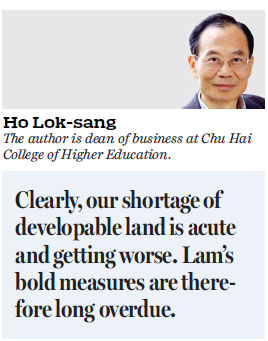CE takes bold steps in the right direction
Updated: 2018-10-11 06:35
(HK Edition)
|
|||||||
Ho Lok-sang explains why he admires new measures announced in the Policy Address - particularly the 'Lantau Tomorrow Vision'
Chief Executive Carrie Lam Cheng Yuet-ngor brought great news to Hong Kong people on Wednesday in her Policy Address. I am particularly impressed with her proposal for a "Lantau Tomorrow Vision" to create 1,700 hectares of land with artificial islands reclaimed from the sea. Although this falls short of the 2,200 hectares proposed by Our Hong Kong Foundation, it is much more than the 1,000 hectares as envisioned in Hong Kong 2030+ originally proposed by the government. Considering that prior to the 1997 handover, the Sino-British Joint Declaration had capped annual land auctions at no more than 50 hectares of land a year, the scale of the proposed reclamation is truly remarkable.
As Lam explained, the objective is "to instill hope among Hong Kong people for economic progress, to improve people's livelihoods and meet their housing and career aspirations". It is expected that the project will provide 260,000 to 400,000 residential units, with 70 percent of this being public housing, accommodating 700, 000 to 1.1 million people. It will in the course of its development create 340, 000 jobs for the next 20 to 30 years.

To give this some perspective, Singapore has expanded its land area through reclamation by at least 24 percent, but only roughly 6 percent of Hong Kong's land area is reclaimed from the sea. Singapore has a population of 5.8 million. This is 22 percent less than that of Hong Kong at 7.4 million but has 30 percent more residential land than Hong Kong. Singapore had 10,000 hectares of residential land as early as 2010. Hong Kong in 2016 only had 7,666 hectares. No wonder Singaporeans are able to live in much roomier flats than Hong Kong people!
Clearly, our shortage of developable land is acute and getting worse. Lam's bold measures are therefore long overdue.
Admittedly, reclamation takes time; it will be decades before the proposed land becomes a reality and before the proposed residential units are available. Meanwhile, other initiatives are moving forward. Under the proposed Land Sharing Pilot Scheme, private land not covered by the government's planned development may be converted to residential land through a fair and highly transparent mechanism. This is exactly what I have proposed. Similarly, industrial buildings will be converted to meet housing needs as a transitional measure. Again I had been making the case that while safety is paramount, properly converted industrial buildings can be healthier and safer than many residential buildings in existence. Another example of bold, innovative thinking is that the government will allow the Hong Kong Housing Society to run an innovative program to allow owners of HKHS' flats to sublet them to needy families without paying off land premiums that they owe. Under a multi-pronged approach, the government "will speed up studies of brownfield sites in the New Territories and make necessary arrangements for reprovisioning existing operations to facilitate housing development".
In her Policy Address, Lam once again referred to her earlier proposal of delinking the selling prices of subsidized flats from the market prices of private flats. Again I have proposed this as an important step in containing the urge to buy as price inflation will outpace income increases. Lam aims to ensure affordability. This is in line with my earlier proposal of linking median prices of for-sale flats to median household incomes. At this time, the specifics about resale conditions and other requirements are not clear. My advice to the government is that original buyers of these flats should be allowed to resell them any time after purchase as long as it is to equally qualified buyers. These flats should not be allowed to be resold in the open market or to buyers not within the target group for assistance. Moreover, the owners must not own other properties or rent out the property. These restrictions would ward off potential investors attracted to buy because the properties sell below market prices.
Another focus of the Policy Address is labor issues. I am glad to see that the controversy over the offsetting arrangement for severance pay in regard to MPF benefits is closer to achieving an amicable solution agreeable to both employers and workers. I had proposed that the government take up the cost of ending the offset arrangement for existing workers. The government has committed funds to soften the burden to employers for up to 25 years. The proposed extension of the statutory maternity leave to 14 weeks is consistent with International Labour Organization recommendations and in line with stated objectives of improving people's livelihoods. I am also quite pleased with the government's committing more resources for the Commission on Children to safeguard the interests and well-being of children.
One area that I hope the government will devote more attention to is industrial safety. The Policy Address does have a paragraph on occupational safety and health; it says that the Labour Department is actively reviewing the penalties of relevant legislation to amplify their deterrent effect. I have written several times on this subject, and believe stiffer penalties are the way to go.
(HK Edition 10/11/2018 page10)